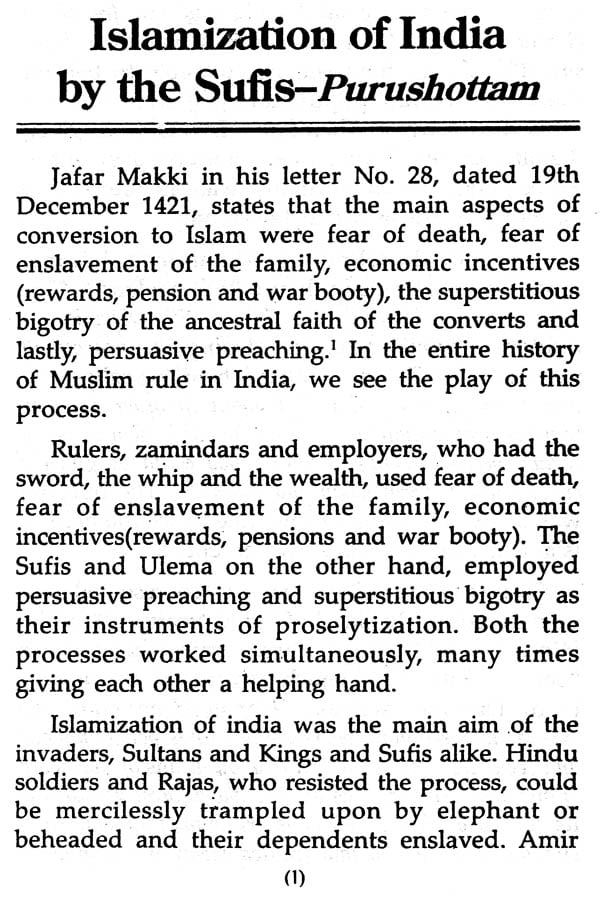
Islamization of India by the Sufis
Book Specification
| Item Code: | NAV666 |
| Author: | Purushottam |
| Publisher: | Suruchi Prakashan, Delhi |
| Language: | English |
| Edition: | 2014 |
| ISBN: | 9789381500859 |
| Pages: | 40 |
| Cover: | PAPERBACK |
| Other Details | 8.50 X 5.50 inch |
| Weight | 50 gm |
Book Description
It is awfully propagated that Sufism is full of spiritualism and mysticism and could be a very effective means of promoting 'Hindu-Muslim unity' and social harmony, while the fact is otherwise.
Sufism-Another Face of Islamic Proselytization A close examination of the history of Islamic proselytization activities in India proves that Sufism through its missionary activities complemented the conversion of Hindus to Islam.
Sufism, on one hand supported the Muslim invaders and Sultans in their political activities and reckness killings of the Hindus on the other hand, influenced the gullible Hindus through their drama of spiritualism and mysticism.
They did not object to the genocide of the Hindus and enslaving and selling their children and women by the cruel Muslim invaders. Almost all Sufi masters were silent spectators of to the murderous mayhems and reckless plunder of temples and by the marauding hordes across the subcontinent.
They did not object to senseless mass killings of the Hindus and destruction of Hindu templet. Most Sufis came to India either accompanying the invading armies of Islamic marauders or followed them in the wake of sweeping conquests by the soldiers of Islam.
For example (1) Khwaja Moinuddin Chishti was accompaned to Ajmer in 1233 and (2) Khwaja Qutubuddin to Delhi in 1236 both by Shihabuddeen Ghauri, (3) Shaikh Fariduddin came to Pattan (now in Pakistan) in 1265 and (4) Shaikh Nizammddin Auliya of Dargah Hazarat Nizamuddin came to Delhi in 1335 accompanying a contingent of the Muslim invaders. It may be pointed out here that all Sufis supported Quran and Sharia. the great Sufi master of the eleventh century, Al-Qushairi (1072AD) had unanimously declared that there was no discord between the aims of the Sufi Haqiqa and the aims of the Shariah.
Similarly the great Sufi saint Al-Hujuri said that "There is no God save Allah" are the utlimate truth and the words "Muhammad is the apostle of Allah", are the indisputable law for the Sufis. In brief, the Sufism and Islamic Ulema represent the same two aspects of the Islamic faith which are universally accepted by all the Muslims. Throughout the Muslim rule, all Sufis enjoyed full confidence, royal favour and support of the cruel rulers.
According to well-known historian, Dr. K. S. Lal : "Hand in hand with the proselytizing efforts of the rulers was the work of Sufis and Maulvis. From the time of Muhammad bin Tlighdaq (1326-1351) to that Akbar (1556-1605), Bengal had attracted rebels, refugees, Sufi mashaikh, disgruntled nobles and adventures from North India.
Professor K. R. Quanungo has noted that the conversion of Bengal was mainly the work of Barah-Auliyas. Prof. Abdul Karim has also referred to militant Sufi proselytization." (Social History of Muslims in Bengal, pp. 136-138). In this context, Dr. I.H. Qureshi writes : "The fourteenth century was a period of expansion of Muslim authority in Bengal and the adjoing territories. A significant part was played in this process by the warrior saints who were eager to take up the cause of any persecuted community.
This often resulted (in clash) with the native authority, followed, alMost invariably, by annexation." (The Muslim Community of the Indo-Pakistan Subcontinent (610-1947), pp. 70-71. They (Sufis) acted mostly as peaceful missionaries, but if they saw that the espousal of some just cause required military action, they were not averse to fighting.
The Sufis did not adopt the lsmaile technique of gradual conversion they established their Khanqahs and shrines at places which had already a reputation for sanctity before Islam. In brief, the Sufi Mashaikh converted people by both violent and non-violent means, occupied their places of worship and turnved them into Khanqahs and mosques to make Es tern Bengal specially a Muslim land."
"Muslim rulers, soldiers and Sufi Mashaikh left the high and low hardly any choice in the matter. The lower classes of course were more vulnerable "In conclusion it may be emphasised that even when historical forces had been divided the country into a number of independent states consequent on the break-up of the Delhi Sultanate, the work of proselytization continued unabated. Small regions could be dealt with in detail and severe Muslim rulers, orthodox-Ulema and Zealous Sufis worked in the effectively."
(Indian Muslims: Who Are They pp. 58-59, 70). In the following pages, the author Shri Purushottam has explicitly established that Sufis systematically worked hand in hand with the Muslim rulers, their armies and Sunnie and Shia Ulemas in the garb of Sufi spiritualism and mysticism. I hope this small booklet will help in understanding the true colours of the Sufis' activities during the last thirteen centuries.
**Sample Pages**







